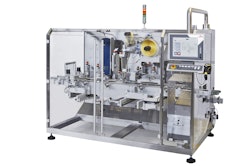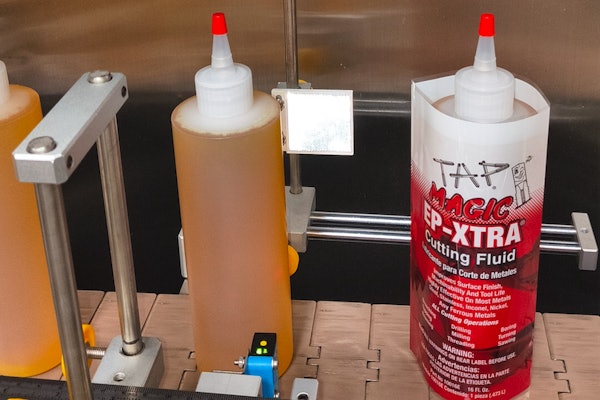Editor’s note: Each year a highlight of the Contract Packaging Association’s Annual Meeting is a Supply Chain Panel made up of heavyweights from at least four different industry verticals. The panelists always represent four areas of supply chain expertise. The panel discussion at this year’s February meeting in Las Vegas was moderated by Eric Wilhelm, CEO at contract packager Coregistics. The overall theme was how packaging might be affected by the consumerization of the retail supply chains. The propensity for consumers to use mobile devices to execute their purchasing behavior, with quick response, changes the way service providers and material suppliers must forecast and deliver in this new economy. Presented here is an edited version of the panel discussion. At the end of each question is a summation by moderator Wilhelm. The panelists were:
Global Retailer: Suzanne Fisher, formerly Director of Packaging, Sam’s Club
Display Co. & Contract Packager: Paul Murphy, Sr. Director of Retail Sales
& New Business Development, Menasha Packaging
CPG Outsourcing Strategist: Lisa Shambro, Executive Director F4SS
(The Foundation for Strategic Sourcing)
Pallet Pooling Innovator: Rex Lowe, President, RL Enterprises
Q: How will consumerization and e-commerce change the way contract packaging is conducted?
Paul: I think the bigger issue around physical displays that we’re facing is the advent of mobile. Mobile has had probably the biggest change in concert with e-commerce. Right now, the balance is shifting towards less physical displays at store. We’re seeing more integration and mobile technology than developments in packaging. To be relevant, Menasha is going to create a new media company around mobile so that we can engage shoppers differently.
Rex: As e-commerce grows, the consumer is going to have to deal with how the product gets delivered to the household and what it comes in. Should that be a throw away or should it be a smart returnable package? In my opinion, it should be the latter.
Suzanne: Obviously, e-commerce is growing for everybody. I have major brand companies telling me “uh oh, the good news is we’re growing; the bad news is we don’t really know how to package for e-commerce.” What I think is scaring the brand folks is that they think they need to have one package that fits all retail channels. But we all know that’s not the case.
Eric’s note: We believe that e-commerce will drive incremental revenue in contract packaging, and here’s why. Retailers will increase product differentiation to enhance customer loyalty and compete against big box cannibalization resulting from e-commerce/consumerization. At the same time, even the largest retailers will lean on contract packagers for innovation and parcel-safe packaging to ensure a pleasant, personalized brand experience. Be aware, e-commerce will allow manufacturers to ignore the need for high-end graphics on parcel packaging. The packaging “look” in that vertical has no relevance on the buying decision.
Q: What one thing do brand owners need to do or stop doing to ensure the future success of their supply chain?
Lisa: I think the biggest challenge for brand marketers is to remove the silos within their organizations. What we find is you have one group that is the packaging group, and then another group that is distribution, and then another group that is contract manufacturing or external manufacturing. They don’t look across the silos to see how they can optimize the integration. I know that some companies within the industry have begun to see the opportunity that exists by more vertical integration, yet the brand marketing companies, because of how they’re organized, don’t often afford them the opportunity to take advantage of that. We have seen isolated examples of some visionary senior leaders who have looked across that. I will use General Mills and their holistic margin management as an example, but they are more the exception than the rule.
Paul: This is a major issue for our business nationally. What the CPGs could do is stop investing in a broken supply chain model, that’s the number one thing. The second thing they can do is engage their shopper or their customer where they are and not believe that the way they’ve done things for the last hundred years is the way they should continue to do it. They must really understand the dynamics of change and not try to continue to push back on that. There is some good CPG behavior in that area.
Eric’s note: We have to keep learning. We need to ensure we have a diverse demographic within our halls and brain trust. Only by testing our forward-looking strategies against known and evolving consumer and brand behavior will we be relevant. Think of it this way: The services we provide will evolve at a speed and service variety directly proportional to advancements in consumer technology.
Q: Is product differentiation a growing emphasis for brand owners and retailers, or is it declining in importance?
Suzanne: One of the things that we’re doing with the differentiation is we’re focusing on regional buying. It was interesting because we met this morning for breakfast and someone said “I thought you already focused on regional buying.” It’s true of course, but now we’re really focusing on regional buying. We are starting with our Dallas office, where the buyers literally are in that Dallas major metro area. Think about it, you might have product differentiation that’s pertinent to that region, let’s say Kansas City with Gates BBQ. We’re having groups buying regionally. You no longer can whip off 10,000 pallet skirts or whatever for your display pack that you just manufactured. You might be doing 100 for St. Louis and then 100 again for each region. We see digital printing growing in co-packer facilities to meet this demand.
Eric’s note: When the future arrives, product differentiation variety will be equal to the number of consumers purchasing that product, period.
Q: How does a Contract Packaging supplier break through the credibility portal and demonstrate value over price?
Lisa: If we go back through history, the people who are managing this part of the business for brand and marketing companies had come from procurement, that’s traditional. What are the great skill sets among procurement professionals? It was about ringing every last tenth of a cent out of the price of goods. It’s not really about creating value. The skill set for creating value is fundamentally different than what we see as the traditional skill sets in procurement, which kind of touches on this whole SRM (Supplier Relationship Management) area. The challenge is, how do we help the brand and marketing companies evolve from a more traditional procurement focus in this area to one of value creation? That’s a significant challenge.
The squeezing means doing more with less, and it’s also regressing the relationships that we see between brand/marketing companies and their suppliers. I think that the important thing is to remain vigilant and we in our firm try to do that as best we can. The result is that the brand companies will then look at what a particular company has done; they have worked with a supplier on a collaborative basis and recognize the value that it has created.
As a result, other companies can see that and then hopefully seek to emulate that and begin to drop these barriers. We are seeing it. It’s not a wave, to be clear, but we are seeing it. As you all know, things don’t change overnight and this won’t either. We are seeing some of the beginning steps that brand and marketing companies are looking at the external manufacturers as partners. We see them leveraging opportunities to mutually create value in a way that we haven’t before.
Paul: If you don’t have a value proposition that’s important to anyone, you probably won’t move the deal. However, if you can become important to your customer’s customer and create a collaboration and begin at the beginning with that in mind, you’ll be successful. But you can’t be afraid of your own value. We’ve always talked to procurement, but the reality is, procurement is always going to drive what we do as an industry. If you can create a value to your customer’s customer, you will be very successful.
Eric’s note: This one concept might very well be the greatest separator of big vs. small in contract packaging. A supplier who effectively communicates value from the introductory stage through a longstanding relationship earns credibility and the revenue that comes with it. The advice we repeat to our associates and, in fact, any service provider, is to learn how to proactively demonstrate value, quantify it, illustrate it, and demand that it is a part of the discussion. By staying ahead of the value discussion, price takes care of itself.
Panel Format Note: Every year Moderator Wilhelm includes a lightning round of questions. Panelists are asked to give a bullet point answer to trending topics. Here’s some of that lightening round.
Q: Turnkey or tolling. (Turnkey is known as a full-service process where the contract packager purchases the components/materials and sells a full service, including materials and tolling. Tolling is a relationship where the supplier bills for only the service provided, no components.)
Lisa: The data that we have suggests turnkey is growing and we don’t see that abating any time soon. So if you don’t have a beefed up purchasing organization, you probably want to pursue one.
Paul: From our prospective, turnkey is a better deal. We’re more involved and integrated with the brand and at the rate that CPGs are letting people go, it will probably help our business overall.
Eric’s note: Turnkey is the obvious trend. If you look at the failed contract packagers in the last ten years, most are a result of an inadequate finance and purchasing team to handle the turnkey spend.
Q: Compelling creative or cost efficiency? Which of these benefits should a contract packager promote in attracting CPG business?
Paul: You can have creative that’s efficient, you just have to integrate upstream. The more you can be engaged in the development of the solution around packaging or display, the more effective the supply chain will be.
Eric’s note: The smart contract packager will illustrate compelling creative, all the while demonstrating cost efficiency through effective design. It is our position that there is so much waste in normal CPG work streams that if we can’t design a materials/labor/logistics program that saves a supply chain dollar for every dollar spent on co-pack, we’re not doing our job.
Q: Discuss for the audience current and future trends on smart pallets and pallet design.
Rex: I think the most important feature is that it should be a smart carrier. It should give information to the retailer. I think there’s information we could provide to the retailers if we had our combined pallet plus display devices. Imagine if it were connected to the internet 24/7. We could help with the pilferage issue. We could talk about things like is that unit device itself actually sitting out on the floor where people can shop from it or is it in the back room because it got lost?
I believe that a pallet and/or a container, first of all, needs to be returnable and repairable. It needs to be lightweight but the smart part is probably the biggest feature in that with technology advancements, active tags are no longer a thing of huge expense. It’s feasible now to put a very inexpensive battery driven tag that will hold an incredible amount of information in every pallet and container that’s out there.
That unit load device should be providing information throughout the supply chain and we should eliminate any black holes. Once a product is built, somebody should have complete visibility of what it’s doing all the way down to when a person buys it off the shelf. The technology is there. We will track weight, humidity,
temperature, sell-through, and damage—all through a smart chip.
Eric’s note: The reality is that technology will by default take us on a fast track to a supply chain that requires no people or paper to track inventory flow. Smart pallet and package tags will communicate in plants, warehouses, trucks, and stores. Pallet/package movements will be tracked in the cloud so that real-time inventory is available at a keystroke. Loads will be confirmed, invoiced, and tracked without human or manual data input. Supply chain visibility will be very real time, well beyond our imagination as we created real-time data environments with spreadsheets and databases 20 some years ago. If properly deployed, this technology should render RFID virtually obsolete.
Final Question: How can we develop an industry standard plant certification that covers most of what manufacturers require, something that is recognized and accepted by all manufacturers/brands? Can that model be expanded for retailer requirements as well?
Lisa: Clearly, this is one of the biggest needs in our industry. Originally, for food manufacturers, GFSI certification was designed to be a very industry-accepted audit. That was a great concept, but it really hasn’t played out. At F4SS we created a program called Audit One, and we currently have P&G, J&J, Unilever, L’Oréal, and Estee Lauder who have all agreed to a common audit standard for non-food. We are currently working with material and component suppliers with pilot programs as we speak. Our next phase is contract manufacturing and packaging for non-foods. We are now being barraged with requests for every other category; we see this as a vision for the future. We have also advised the retailers of this, and initially they appear to indicate buy-in.
Eric’s note: We have struggled with industry-recognized certifications for 25 years. The current progress to that end is by far the most promising. These programs indeed have legs.
Eric’s conclusion: This year’s panel stretched our minds on forthcoming technology and collaboration in contract packaging, contract manufacturing, and the upstream and downstream players in our space. We can no longer ignore the power of consumers and their mobile lifestyles. Neither can we ignore rapid advancements in technology and information sharing. Not mentioned in this year’s panel was social media. When bringing all of these contemporary trends together, branded companies need to consider consumer behavior as well as consumer sentiment when designing packaging. More so now than ever, a packaged product goes beyond physical characteristics and is quite often more about the experience. That experience should include brand loyalty, frustration-free packaging, compelling merchandising, convenient delivery, as well as social status. We dinosaurs in the industry had better beware—the times, they are a changin’.
Editor’s Note: The opinions and remarks by the panelists do not necessarily represent the views of their respective companies. Some of their remarks have been condensed or paraphrased in the interest of space constraints.


























